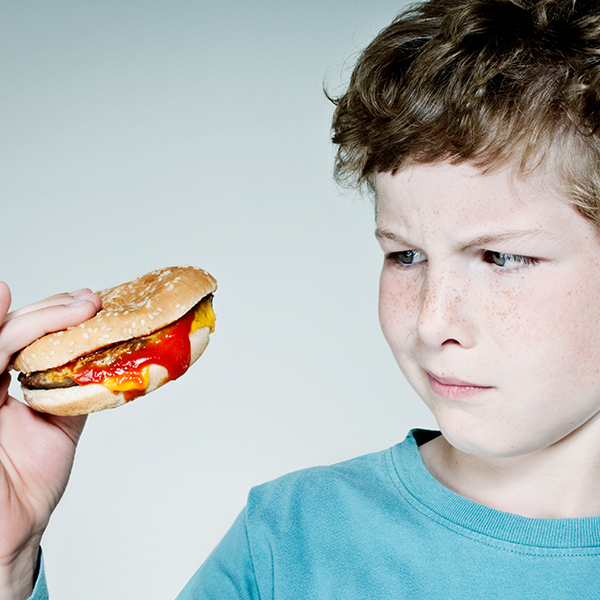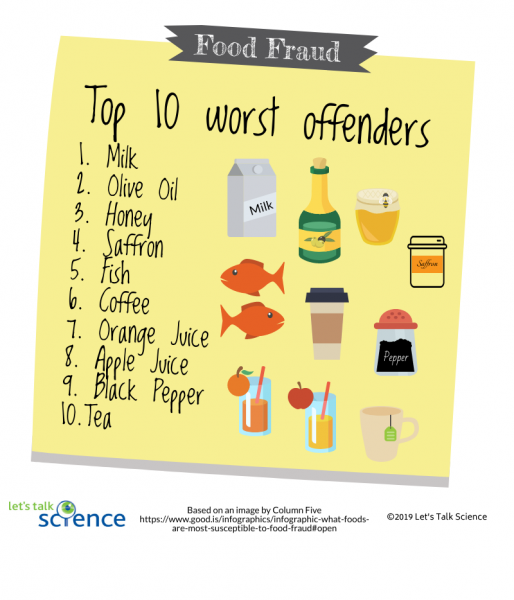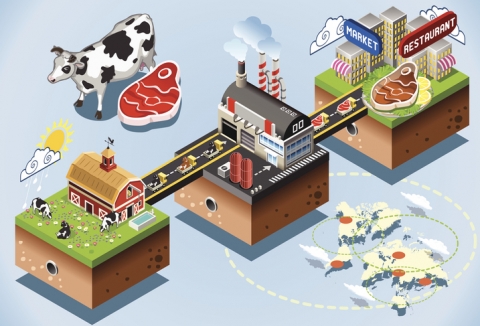Do You Know What's On Your Plate?

A boy looks at a hamburger (ClarkandCompany, iStockphoto)

A boy looks at a hamburger (ClarkandCompany, iStockphoto)
How does this align with my curriculum?
| Grade | Course | Topic |
|---|
In 2013, many Europeans learned their beef lasagnas were actually made of horse meat. Learn about food fraud, and how a Canadian invention can help detect it.
What if your burger was made of horse meat?
In 2013, an enormous horse meat food fraud scandal erupted in Europe. 500 tonnes of horse meat were sold in the form of frozen meals. Another 200 tonnes were sold as “beef” sausages to over a dozen countries in Europe.
The problem was first detected in Ireland. At that time, Ireland was the only country in Europe that tested for horse in meat products. Companies in France, Cyprus, the Netherlands, and Romania were involved in the fraud.
Eating horse meat isn’t necessarily bad for you. Scientists have found few human health risks associated with eating horse meat. But that’s not the point in this case. Most people want to know what they’re eating. They want to know that the labels on their food are correct. Also, for many people the thought of eating horse meat is quite disgusting!
What is food fraud?
This case was an example of food fraud. Replacing beef with horse meat is a type of food fraud called substitution. It involves replacing one product for something else. Usually, the replacement ingredient is lower-quality and less expensive. Horse meat is cheaper than beef. By replacing beef with horse meat, companies make more money.
Substitution is just one type of food fraud. Adulteration is another type. It involves mixing one product with another, but selling it as a pure product. For example, a manufacturer might add canola oil to olive oil, but sell the product as pure olive oil. This is also referred to as dilution.

Making false claims or misleading statements about what a product can do is another form of food fraud. For example, saying a food or food ingredient has been proven to make you smarter would be misleading.
Mislabelling is another common form of food fraud. A manufacturer might mislabel what a product is or where it comes from. For example, when cheaper tilapia fish is labelled as more expensive red snapper, that is mislabelling. The same goes for labelling fruit and vegetables as organic when they have not actually been certified as organic.
What is DNA Barcoding?
Scientists often use DNA barcoding to identify the unknown species in mislabeled meat-based products. This technique was developed by Dr. Paul Hebert at the University of Guelph here in Canada in 2003.
DNA barcoding involves taking small samples of meat and sequencing a standard portion of mitochondrial DNA from a specific gene in the DNA of a species. For animal species, this is the cytochrome oxidase I (COI or COX1) gene. The sequence from this gene can identify an exact species, like a horse or a cow.
DNA barcoding has become an important tool of taxonomy, or biological classification. Scientists use DNA barcoding along with observations of physical specimens of animals or plants to help classify a species. It can help a taxonomist distinguish one species from another. That’s because each species has a unique DNA barcode. When two species look identical, the barcode can reveal a difference at the DNA level. Even a small piece of an animal or plant can be barcoded to identify a species. Scientists can barcode a wing, a piece of skin, or a leaf!
Have you ever seen a mixture of chopped meat? It is impossible to tell different types of meat apart just by looking. But DNA barcoding can determine the exact species the mixture contains.
Back in the food fraud scandal of 2013, the Irish Foods Standards Agency (FSA) analyzed lasagnas from one company with DNA barcoding. They found that specific products contained between 60% and 100% horse meat! The FSA declared the meat substitution was the result of deliberate fraud. Fraud is a criminal activity.
Did you know?
As a result of the European horse meat scandal, a National Food Crimes Unit (NFCU) was set up in the United Kingdom in 2015.
Did Canadians have to worry about the contents of meat products bought in Canada? Fortunately, no. The Canadian Centre for DNA Barcoding, located at The University of Guelph’s Biodiversity Institute of Ontario (BIO), acted quickly. As soon as they heard about the scandal, researchers at the Centre tested hamburgers from 15 different sources. They found that none of them contained horse meat. Just like their labels promised, they contained 100% beef! This was great news for Canadian consumers.
What are the social impacts of food fraud?
What are the consequences of a food fraud incident this big? Well, it took many people, lots of time, lots of money and lots of effort to identify the problem. The companies selling the mislabeled products had to do an enormous food recall. Over 200 million burgers were recalled, as well as most lasagnas sold in Europe. Some of the food processing companies and meat distributors lost a lot of money, too.
This case also involved a long criminal investigation of the people involved in the fraud. Many people went to court. One man was prosecuted in 2015. Another four men were finally charged and sentenced with fines and jail time in 2019.
Did you know?
It is estimated that food crime costs the global food industry between $10 billion and $50 billion each year.

When a food fraud scandal as big of this happens, governments get involved. Government agencies responsible for food safety and inspection in each country had to examine the situation closely. They had to look at how the policies and procedures within their own countries may have led to this food supply chain contamination. Agencies that handled food import and export between countries had to take a close look, too.
But there’s another problem with food fraud cases this big. They can make consumers like you and me lose trust in our food providers. In the 2013 scandal, people would have wasted money on a food product they didn’t want. They would have wasted food when they threw the product out or returned it. They may have even felt duped by food manufactures. Some people may have even stopped eating meat altogether!
Today, people consider the horse meat scandal of 2013 a major turning point in food fraud history. It clearly showed how food can be highly vulnerable to serious, widespread crime on an international scale.
Starting Points
- What are your reactions to the horse meat food fraud story?
- Do you trust that the food you buy is what it says it is on the label? Explain.
- How would you feel if you thought you were eating beef and it turned out to be horse meat?
- What are the advantages and disadvantages of relying on DNA barcoding technology for monitoring food composition?
- What are some of the impacts of food fraud in our society?
- Was there any way for European governments to anticipate that this type of food substitution fraud might occur? How could it have been prevented?
- What is DNA barcoding?
- If you were going to substitute a different animal for beef (meat from cattle) that is closely related, what would you choose?
- How is food quality and safety monitored in Canada? (Note: This question requires addition research)
- Is DNA barcoding a scientific study, a technology or a tool? Explain.
- How is DNA barcoding transforming the food industry?
- This food fraud story scared and turned some European consumers off from eating and trusting beef products. What type of media story would reassure the public that a meat substitution problem had resolved? Which type of media story has more power to sway public opinion? Explain.
- What have you seen or heard in the media about food fraud? Are there examples of food fraud that seem to be fairly common?
- This article can be used for Grade 11 and 12 Health, Food & Nutrition, Business & Economics, Biology, Technology & Engineering and Biotechnology related to taxonomy, food safety, industrial biotech and DNA structure. Concepts introduced include food fraud, substitution, adulteration, dilution, making false claims, misleading statements, mislabelling, DNA barcoding, DNA sequencing, mitochondrial DNA, cytochrome oxidase I (COI or COX1) gene, taxonomy, classification, specimens, taxonomist, food recall and food supply chain.
- Before reading this article, teachers could have students learn about DNA Barcoding in general by reading a backgrounder like, The Classification of Life: From Linnaeus to DNA Barcoding.
- This application article could also be used as an interesting hook for first introducing the concept of DNA barcoding and identifying species using this technique.
- To consolidate learning after reading this article, teachers could have students complete a Concept Definition Web learning strategy for the concept of food fraud. Ready-to-use Concept Definition Map reproducibles are available in [Google doc] and [PDF] formats.
- To explore the topic further, teachers could have students conduct a Consequence Mapping learning strategy. Students could create a consequence map outlining all the potential implications of a meat substitution situation. Download ready-to-use reproducibles using the Consequence Map learning strategy for this article in [Google doc] and [PDF] formats.
- For a hands on science experience related to using DNA barcoding for identifying food fraud, teachers could have students participate in the Fish Market Survey Project.
Connecting and Relating
- What are your reactions to the horse meat food fraud story?
- Do you trust that the food you buy is what it says it is on the label? Explain.
- How would you feel if you thought you were eating beef and it turned out to be horse meat?
Relating Science and Technology to Society and the Environment
- What are the advantages and disadvantages of relying on DNA barcoding technology for monitoring food composition?
- What are some of the impacts of food fraud in our society?
- Was there any way for European governments to anticipate that this type of food substitution fraud might occur? How could it have been prevented?
Exploring Concepts
- What is DNA barcoding?
- If you were going to substitute a different animal for beef (meat from cattle) that is closely related, what would you choose?
- How is food quality and safety monitored in Canada? (Note: This question requires addition research)
Nature of Science/Nature of Technology
- Is DNA barcoding a scientific study, a technology or a tool? Explain.
- How is DNA barcoding transforming the food industry?
Media Literacy
- This food fraud story scared and turned some European consumers off from eating and trusting beef products. What type of media story would reassure the public that a meat substitution problem had resolved? Which type of media story has more power to sway public opinion? Explain.
- What have you seen or heard in the media about food fraud? Are there examples of food fraud that seem to be fairly common?
Teaching Suggestions
- This article can be used for Grade 11 and 12 Health, Food & Nutrition, Business & Economics, Biology, Technology & Engineering and Biotechnology related to taxonomy, food safety, industrial biotech and DNA structure. Concepts introduced include food fraud, substitution, adulteration, dilution, making false claims, misleading statements, mislabelling, DNA barcoding, DNA sequencing, mitochondrial DNA, cytochrome oxidase I (COI or COX1) gene, taxonomy, classification, specimens, taxonomist, food recall and food supply chain.
- Before reading this article, teachers could have students learn about DNA Barcoding in general by reading a backgrounder like, The Classification of Life: From Linnaeus to DNA Barcoding.
- This application article could also be used as an interesting hook for first introducing the concept of DNA barcoding and identifying species using this technique.
- To consolidate learning after reading this article, teachers could have students complete a Concept Definition Web learning strategy for the concept of food fraud. Ready-to-use Concept Definition Map reproducibles are available in [Google doc] and [PDF] formats.
- To explore the topic further, teachers could have students conduct a Consequence Mapping learning strategy. Students could create a consequence map outlining all the potential implications of a meat substitution situation. Download ready-to-use reproducibles using the Consequence Map learning strategy for this article in [Google doc] and [PDF] formats.
- For a hands on science experience related to using DNA barcoding for identifying food fraud, teachers could have students participate in the Fish Market Survey Project.
Learn more
Infographic: What Foods are Most Susceptible to Food Fraud? (2013)
Infographic from Source Five depicting the foods that are the most common culprits of food fraud
Food Fraud on the Rise (2013)
Short news video (2:45 min.) from CNN discusses common household food items that are susceptible to food frauds and some easy ways to avoid them
Food Supply Chain Basic Intro (2015)
Short video (2:12 min.) illustrating the basic concepts of food supply chains
Andy Morling talks about Food Crime (2016)
A short video (1:26 min.) from the Food Standards Agency discussing some of the issues around food crime in the United Kingdom and around the world.
Food Crime: What you need to know (2018)
A video (2:10 mins.) from the Foods Standards Agency explains what food crime is, and some of the dangers that it poses.
References
BBC News. (2019, January 21). Horsemeat scandal: Trial of firms accused of selling horse as beef opens in Paris.
Food Standards Agency. (2015). Timeline on horse meat issue.
Government of Canada. (2019, January 25). Types of food fraud.
Keogh, J. (2019). Food fraud – Lessons from history. Global Food Safety Resource.
Spink, J. (2014, May 8). GFSI direction on food fraud and vulnerability assessment (VACCP). Michigan State University.